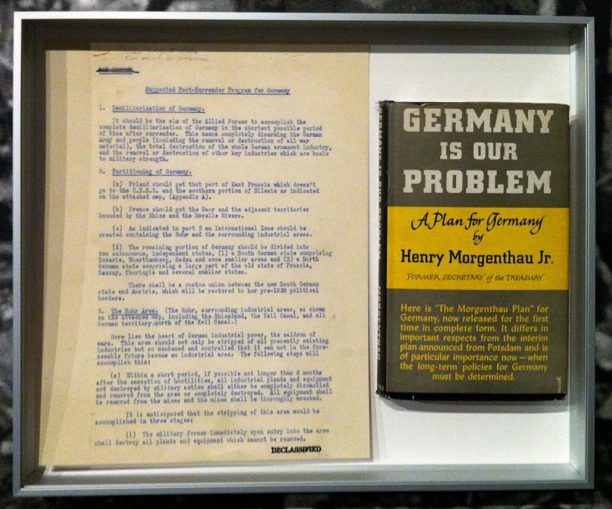
X enter x [CC BY-SA 3.0], via Wikimedia Commons
The idea for this came from some bar steward who read a comment I had made, imagine that , people reading the comments, perfidy I tell you. Anyway it seems the Morgenthau Plan may not be widely known so this article will attempt to enlighten some of you to some degree.
Towards the end of the second world war, the allies needed to start planning what to with Germany once hostilities were finished. The war to end all wars had resulted in another one after 21 years. Obviously something different was required or the 1960s might have seen yet another resurgence of German precision marching.
Henry Morgenthau Junior was the US Secretary of the Treasury and in early September 1944, he produced a document called Suggested Post-Surrender Program for Germany. He reputedly had a lot of help from Harry Dexter White, a senior US Treasury official and Russian spy. Morgenthau’s plan was never implemented, instead we ended up with the Marshall Plan whereby the US gave Western Europe $12 billion, that is nearly $100 billion in 2018 dollars) to help rebuild their economies. The plan ran for 4 years and resulted in $17 billion being handed out. The UK received almost $3.3 billion of this Aid, much of it was promptly spunked up the wall by Atlee to build his socialist paradise.
The Morgenthau plan was controversial, it had the appearance of punishing the Germans, something my thoughts approve of. Don’t forget, that 90 odd percent of Germans who loved the little Austrian disappeared into the shadows on VE day and you were hard pressed to find a Nazi anywhere in the former third Reich. Denying everything comes from the socialist part of the Nazi name.
Morgenthau’s plan had three main components.
- Demilitarisation of Germany
- Partitioning of Germany
- Restricting German Industry
The demilitarisation part consisted of disarming the German Army and people. This required the removal or destruction of
- All War materiel
- The German armament Industry
- Other key Industries that contributed to military strength
It should be pointed out that German re-armament after World War 1 began in the 1920s. It was not, as is often believed, initiated by the Nazis. It seems the Establishment and the Military were determined to carve out an Empire for Germany and would use military means to do it. The Versailles Treaty specifically forbade this so they sneakily reached an agreement with Russia where they could test the equipment and train the troops in isolated parts of the Soviet Union. That worked out well for the commies.
The Partitioning of Germany involved removing what Hitler had grabbed up to WW2 and returning it to its previous owner plus chopping Germany into several smaller states.
- Poland to get East Prussia and the southern part of Silesia (adjacent to the Czech Republic).
- France to get Saarland and adjacent territories.
- The Ruhr and surrounding industrial areas to be part of an international zone
- Austria to be restored to its pre-1938 borders.
- The rest of Germany to be divided into a North part and a South part.
The restricting German Industry part was quite draconian. The Germans were to be told they would not be allowed to develop any industry that could be used for making war material. The reparations nonsense of WW1 was not to be repeated, instead the occupying powers would be able to strip Germany of its industry and plant. Any workers with special skills or technical training should be encouraged to migrate to other areas and widely dispersed.
This was quite a punishment for the Germans, no doubt Harry Dexter White was egged on by his Soviet handlers and Morgenthau, who was Jewish, would not look upon the Germans kindly. The plan was unveiled on about September 12th 1944 at the Second Quebec Conference between Roosevelt and Churchill.
Although this plan had some influence on the fate of the fatherland, it was not implemented. Goebbels got wind of this plan and used it to exhort the Germans to further efforts, otherwise look what will happen to us. Initially Roosevelt was not opposed to the plan but there was some resistance from those who thought it would make the Germans fight all the more. Churchill was opposed to the plan and the Conference broke up without agreement. Morgenthau and White continued discussions with Lord Cherwell, Churchill’s personal assistant. Cherwell was vehemently anti Nazi and eventually convinced Churchill of the Plan’s merits.
The offer of six and a half billion dollars in credits from the US to the UK was probably the most convincing argument Churchill heard. So having effectively agreed the plan, the US then stepped back from it. In May 1945 Truman approved a policy that directed the US forces in Germany to take no steps toward the economic rehabilitation of Germany nor steps designed to maintain or strengthen the German economy but it did not include Morgenthau’s proposition.
After the Potsdam Conference in the second half of July 1945 the final plans for Germany were put into place. The Morgenthau Plan was on its last legs. Would it have worked, probably not but it may have given the Germans the idea that the Allies would not stand for them kicking off again. And as we are all aware, they haven’t kicked off militarily since 1945 but the have used the EEC /EU to once again dominate Europe. Hopefully we have put a nail in that coffin with our Brexit, may we be the first of many others to unchain ourselves from the corpse that is the Fourth Reich.
© well_chuffed 2019
The Goodnight Vienna Audio file



